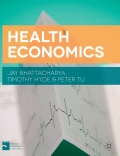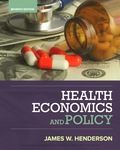
Concept explainers
(a)
Determine the health disparity.
(a)
Explanation of Solution
The health disparity in Town E can be calculated, since the cancer rate is 50% for nobles and 40% of peasants, as follows:
Hence, in Town E chance of nobles contracting cancer is 25% more than that for peasants.
The health disparity in Town W can be calculated, since the cancer rate is 10% for nobles and 8% of peasants, as follows:
Hence, in Town W chance of nobles contracting cancer is 25% more than that for peasants.
Therefore, in both towns, the chances for nobles contracting cancer is 25% more than that for peasants
(b)
Determine the nationwide cancer rate for nobles as well as peasants.
(b)
Explanation of Solution
The number of nobles having in cancer in Town E and Town W can be calculated as follows:
Thus, the total number of nobles having in cancer in both towns is 140.
The total number of nobles in both Towns E and W is
Thus, the nationwide cancer rate for nobles is 14%.
The number of peasants having cancer in Town E and Town W can be calculated as follows:
Thus, the total number of peasants having cancer in both towns is 440.
The total number of nobles in both Towns E and W is
Thus, the nationwide cancer rate for peasants is 29.33%.
Therefore, the nationwide cancer rate is higher for peasants.
(c)
The Simpson’s paradox.
(c)
Explanation of Solution
As Part (a) explains that the region wise health disparity is higher for nobles, while the nationwide disparity is higher for peasants. This effect is called ‘Simpson’s paradox’. This Simpson’s paradox exists because the number of Peasants is higher than the number of nobles. Therefore, a small percentage of peasants having cancer translates to larger absolute number. That is, the absolute number of peasants is 1,500, while the absolute number of nobles is 1,000. Even in geographical perspective, the absolute number of peasants is very high (1000 peasants) for Town E than Town W (500 peasants). Therefore, even though the rate of getting cancer in Town E is smaller for peasants, it turns out that 400 peasants have cancer and only 50 nobles have cancer in Town E. Hence, the health disparity is mainly due to the socioeconomic status.
(d)
Determine the three conditions for the situation of Simpson’s paradox.
(d)
Explanation of Solution
The three conditions for the situation of Simpson’s paradox are listed below (using Table 4.7):
- In Town E, ‘a’ amount of nobles live in which ‘w’ suffer with cancer, and ‘b’ amount of peasants live in which only ‘x’ suffer from cancer. This means the cancer rate of nobles should be greater than the cancer rate of peasants.
- The above explained condition must be same for Town ‘W’. This means the rate of people who suffer with the cancer should be higher for nobles than the peasants.
- The third and final condition is that the nationwide disparity for peasants should be higher than nobles. Hence, the total population (b and d) of peasants together should be higher than the total population of nobles (a and c).
(e)
Prove that Simpson’s paradox will not occur if the population of nobles and peasants are same in both towns.
(e)
Explanation of Solution
As explained, Simpson’s paradox occurs if the rate of cancer is high among nobles in individual towns, while it is high among peasants in nationwide. This happens mainly due to difference in population between nobles and peasants. Assume that the situation of the same population of the nobles and peasants in both towns, then what happen is that the cancer rate will be also less in both the cases. As a result, the nationwide result will also change, that is, the nobles will be more in number of suffering cancer. Hence, Simpson’s paradox will not occur if the population and peasants are same in both towns.
(f)
Determine whether Simpson’s paradox may invalidate due to some of the evidence for health disparities.
(f)
Explanation of Solution
According to the efficient producer hypothesis, better educated individuals are more efficient producers of health than less well-educated individuals. As a result, health disparity will exist between well-educated people and less educated people. In this case, nobles can be consider as the well-educated people and peasants can be consider as less-educated people. As per the efficient producer hypothesis, nobles should have better health than peasants. However, in this case, nobles suffer more from cancer in individual towns. Hence, Simpson’s paradox, might extent invalidate some of the evidence for the health disparities.
Want to see more full solutions like this?
- After the ban is imposed, Joe’s firm switches to the more expensive biodegradable disposable cups. This increases the cost associated with each cup of coffee it produces. Which cost curve(s) will be impacted by the use of the more expensive biodegradable disposable cups? Why? Which cost curve(s) will not shift, and why not? Please use the table below to answer this question. For the second column (“Impacted? If so, how?”), please use one of the following three choices: No shift; Shifts up (i.e., increases: at nearly any given quantity, the cost goes up); or Shifts down (i.e., decreases: at nearly any given quantity, the cost goes down). $ Cost Curve Impacted? If so, how? Explanation of the Shift: Why or Why Not AFC No shift. Fix costs stay the same, regardless of quantity. Fixed cost is calculated as Fixed Cost/Quantity. Since fixed costs remain unchanged, AFC stays the same for each quantity. MC Shifts up. Since the biodegradable cups are more expensive, the…arrow_forwardStyrofoam is non-biodegradable and is not easily recyclable. Many cities and at least one state have enacted laws that ban the use of polystyrene containers. These locales understand that banning these containers will force many businesses to turn to other more expensive forms of packaging and cups, but argue the ban is environmentally important. Shane owns a firm with a conventional production function resulting in U-shaped ATC, AVC, and MC curves. Shane's business sells takeout food and drinks that are currently packaged in styrofoam containers and cups. Graph the short-run AFC0, AVC0, ATC0, and MC0 curves for Shane's firm before the ban on using styrofoam containers.arrow_forwardd-farrow_forward
- a-c pleasearrow_forwardd-farrow_forwardPART II: Multipart Problems wood or solem of triflussd aidi 1. Assume that a society has a polluting industry comprising two firms, where the industry-level marginal abatement cost curve is given by: MAC = 24 - ()E and the marginal damage function is given by: MDF = 2E. What is the efficient level of emissions? b. What constant per-unit emissions tax could achieve the efficient emissions level? points) c. What is the net benefit to society of moving from the unregulated emissions level to the efficient level? In response to industry complaints about the costs of the tax, a cap-and-trade program is proposed. The marginal abatement cost curves for the two firms are given by: MAC=24-E and MAC2 = 24-2E2. d. How could a cap-and-trade program that achieves the same level of emissions as the tax be designed to reduce the costs of regulation to the two firms?arrow_forward
- Only #4 please, Use a graph please if needed to help provearrow_forwarda-carrow_forwardFor these questions, you must state "true," "false," or "uncertain" and argue your case (roughly 3 to 5 sentences). When appropriate, the use of graphs will make for stronger answers. Credit will depend entirely on the quality of your explanation. 1. If the industry facing regulation for its pollutant emissions has a lot of political capital, direct regulatory intervention will be more viable than an emissions tax to address this market failure. 2. A stated-preference method will provide a measure of the value of Komodo dragons that is more accurate than the value estimated through application of the travel cost model to visitation data for Komodo National Park in Indonesia. 3. A correlation between community demographics and the present location of polluting facilities is sufficient to claim a violation of distributive justice. olsvrc Q 4. When the damages from pollution are uncertain, a price-based mechanism is best equipped to manage the costs of the regulator's imperfect…arrow_forward
- For environmental economics, question number 2 only please-- thank you!arrow_forwardFor these questions, you must state "true," "false," or "uncertain" and argue your case (roughly 3 to 5 sentences). When appropriate, the use of graphs will make for stronger answers. Credit will depend entirely on the quality of your explanation. 1. If the industry facing regulation for its pollutant emissions has a lot of political capital, direct regulatory intervention will be more viable than an emissions tax to address this market failure. cullog iba linevoz ve bubivorearrow_forwardExercise 3 The production function of a firm is described by the following equation Q=10,000-3L2 where L stands for the units of labour. a) Draw a graph for this equation. Use the quantity produced in the y-axis, and the units of labour in the x-axis. b) What is the maximum production level? c) How many units of labour are needed at that point? d) Provide one reference with you answer.arrow_forward

 Economics (MindTap Course List)EconomicsISBN:9781337617383Author:Roger A. ArnoldPublisher:Cengage Learning
Economics (MindTap Course List)EconomicsISBN:9781337617383Author:Roger A. ArnoldPublisher:Cengage Learning

 Exploring EconomicsEconomicsISBN:9781544336329Author:Robert L. SextonPublisher:SAGE Publications, Inc
Exploring EconomicsEconomicsISBN:9781544336329Author:Robert L. SextonPublisher:SAGE Publications, Inc





